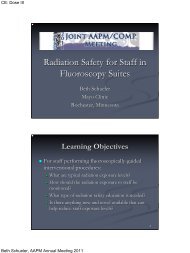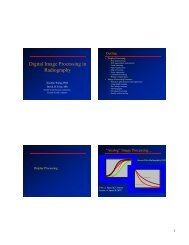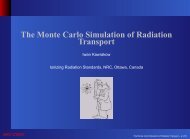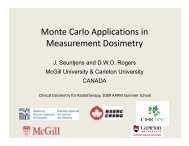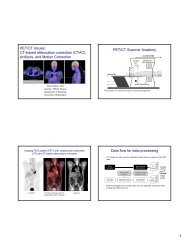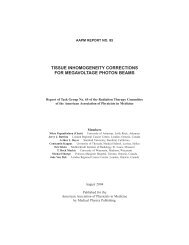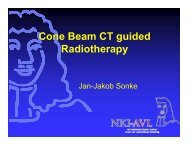Dosimetry for IMRT
Dosimetry for IMRT
Dosimetry for IMRT
- TAGS
- dosimetry
- imrt
- www.aapm.org
You also want an ePaper? Increase the reach of your titles
YUMPU automatically turns print PDFs into web optimized ePapers that Google loves.
<strong>Dosimetry</strong> <strong>for</strong> <strong>IMRT</strong><br />
Thomas Rockwell Mackie<br />
Department of Medical Physics<br />
University y of Wisconsin<br />
Madison WI<br />
trmackie@wisc.edu
Financial Disclosure<br />
I am a founder and Chairman of TomoTherapy<br />
Inc. (Madison, ( , WI) ) which is participating p p g in the<br />
commercial development of helical tomotherapy.
Outline<br />
• <strong>Dosimetry</strong> Issues Relevant to <strong>IMRT</strong><br />
• Charged Particle Equilibrium<br />
• Temporal Non-Constancy<br />
• Partial Volume Effects<br />
• Non-Standard Fields<br />
• <strong>IMRT</strong> as a Large Collection of Small Non-Standard Fields<br />
• IAEA Calibration Initiative <strong>for</strong> Non-Standard Non Standard Fields<br />
• Patient-Specific Methods To Verify Delivery of <strong>IMRT</strong><br />
• Independent Calculations<br />
• Delivery of Individual Radiation Fields<br />
• Delivery of All Fields into a Phantom<br />
• Metrics <strong>for</strong> Patient-Specific Patient Specific <strong>Dosimetry</strong> QA
<strong>Dosimetry</strong> Issues<br />
Relevant to <strong>IMRT</strong><br />
• Charged particle equilibrium<br />
– Different spectrum <strong>for</strong> collection of small fields<br />
– NNon-uni<strong>for</strong>m if dose d<br />
• Temporal non-constancy<br />
– A very small effect <strong>for</strong> ion chambers<br />
– May not be true <strong>for</strong> other dosimeters<br />
• Partial volume effect<br />
– Most important effect especially when measuring<br />
output p<br />
factors <strong>for</strong> small fields
Non-Uni<strong>for</strong>m Intensity Changes the<br />
Energy gy Spectrum p<br />
Photon<br />
Photon<br />
Beamlet<br />
Beamlet<br />
More High<br />
Energy gy<br />
Electrons<br />
More Low<br />
Energy<br />
Electrons
Change in Stopping Power Ratio<br />
Comparison of Spencer-Attix (∆=10 keV) restricted mass collisional stopping<br />
powers ratios (water/air) at 5 cm depth in water <strong>for</strong> various 6 MV beams with<br />
stereotactic and MLC beams.<br />
6 MV beams Beam quality,<br />
TPR(20,10)<br />
Andreo,<br />
(1994)<br />
Sánchez-<br />
Doblado,<br />
(2003)<br />
El Elekta kt SL-18 SL 18<br />
10 x 10 cm<br />
0 690 1 1187 1 1188 1 000<br />
2<br />
0.690 1.1187 1.1188 1.000<br />
1.0 cm diameter<br />
stereo field<br />
0.3 cm diameter<br />
stereo field<br />
Siemens Primus<br />
10 x 10 cm 2<br />
2 x 2 cm 2 irregular<br />
on-axis beamlet<br />
2 x 2 cm 2 irregular<br />
8 cm off-axis<br />
1.1155 0.997<br />
1.1153 0.997<br />
0.677 1.1213 1.1221 1.001<br />
1.1203 0.999<br />
1.1250 1.003<br />
Column4/Column3
Signal (fC)<br />
12000<br />
10000<br />
8000<br />
6000<br />
4000<br />
2000<br />
0<br />
-2000<br />
0.16 0<br />
Temporal Delivery of <strong>IMRT</strong><br />
46.9 46<br />
93.7 93<br />
Delivery of Dose to a Single Voxel<br />
141 1<br />
188 1<br />
235 2<br />
282 2<br />
329 3<br />
376 3<br />
423 4<br />
<strong>IMRT</strong> Delivery Signatures<br />
470 4<br />
517 5<br />
Step & Shoot HIART<br />
564 5<br />
613 6<br />
658 6<br />
702 7<br />
747 7<br />
Elapsed Time (sec)<br />
From Tim Holmes, St. Agnes Baltimore<br />
792 7<br />
836 8<br />
881 8<br />
926 9<br />
971 9<br />
10015<br />
10060<br />
11105<br />
11149<br />
11194<br />
12239
Cumulative<br />
Dose<br />
Normalized<br />
1<br />
0.9<br />
0.8<br />
0.7<br />
0.6<br />
0.5<br />
04 0.4<br />
0.3<br />
0.2<br />
01 0.1<br />
0<br />
Temporal Delivery of <strong>IMRT</strong><br />
DDelivery li of f DDose tto a Si Single l Voxel V l<br />
5 %<br />
90 %<br />
5 %<br />
Step and Shoot Helical Tomo<br />
0 1 2 3 4 5 6 7 8 9 10 11 12 13 14 15 16 17 18 19 20 21<br />
Elapsed Time (minutes)<br />
From Tim Holmes, St. Agnes Baltimore
Outpuut<br />
Factorr<br />
0.9<br />
0.8<br />
00.7<br />
0.6<br />
05 0.5<br />
0.4<br />
03 0.3<br />
Partial Volume Effect<br />
Dose to Water For Small Fields<br />
MMonte t CCarlo l<br />
Diamond<br />
Diode<br />
LAC+film<br />
Film<br />
PTW 31014 (Pinpoint)<br />
PTW 31010 (Semiflex)<br />
PTW 30006 (Farmer)<br />
0.2<br />
0.5 1.0 1.5 2.0 2.5 3.0<br />
Side of Square Field (cm)<br />
From Roberto Capote, IAEA
output o factor<br />
rel to 4x4<br />
1.10<br />
100 1.00<br />
0.90<br />
0.80<br />
0.70<br />
0.60<br />
0.50<br />
0.40<br />
Partial Volume Effect<br />
output factors relative to 4 cm x 4 cm<br />
standard data<br />
photon diode<br />
di diamond d<br />
pinpoint<br />
0.125 cc chamber<br />
electron diode<br />
0 1 2 3 4 5 6 7 8 9 10<br />
equivalent field lenght (cm)<br />
From Karen Rosser, Royal Marsden
High Uncertainty in Output Factors<br />
EExample: l St Statistics ti ti of f 45 OOutput t t Factors F t <strong>for</strong> f 6 mm and d 18 mm square fi fields ld<br />
(Novalis, SSD = 1000 mm, depth = 50 mm, various detectors)<br />
Factor of Two in<br />
Beam Calibration!<br />
From Wolfgang Ullrich, BrainLab
Reasons <strong>for</strong> Drop in Output<br />
with Small Field Size<br />
• Backscatter into monitor unit from<br />
beam defining jaws<br />
• Reduced scatter (phantom and head)<br />
• Electronic disequilibrium<br />
• Obscuration of the source
Problems with Conventional Output<br />
Factors<br />
Standard Reference<br />
Conditions<br />
Small Field<br />
Conditions<br />
• Small field<br />
openings p g obscure<br />
the source which is<br />
difficult to measure<br />
and error prone.<br />
• Amount of phantom<br />
scatter changes as<br />
well as lateral<br />
disequilibrium<br />
disequilibrium.<br />
• Partial volume<br />
effects can mask<br />
machine output<br />
factor.
Scan Phantom Across a Narrow Beam<br />
Jaw field width (FW)<br />
• If the source were a point source, source the<br />
measured primary dose would be<br />
directly proportional to the jaw field<br />
width and inversely proportional to the<br />
scan speed.<br />
• Nearly equal phantom scatter conditions<br />
<strong>for</strong> all jaw settings.<br />
• No partial volume effects once scanning<br />
is complete.<br />
Beam’s eye view
Animation of Scanning Path<br />
From the Point of View of the Phantom<br />
The fan beam<br />
field 10 cm long<br />
by FW wide<br />
FW is i the fan f beam be width idth<br />
bbegins i at one<br />
Th The ffan bbeam<br />
side of the field<br />
field is always<br />
and is scanned<br />
scanned the<br />
across the<br />
same distance<br />
phantom. FW is<br />
(10 cm) at the<br />
defined by the<br />
50% to 50%<br />
same speed. speed<br />
dose.<br />
Beam’s eye view
Scanning at Velocity v<br />
Assume that the source is a point source<br />
Jaw field width (FW)<br />
� �<br />
( r)<br />
Dr ( )<br />
10 cm
Animation of Scanning Path<br />
From the Point of View of the Phantom<br />
The fan beam<br />
field 10 cm long<br />
by FW wide<br />
FW is i the fan f beam be width idth<br />
bbegins i at one<br />
Th The ffan bbeam<br />
side of the field<br />
field is always<br />
and is scanned<br />
scanned the<br />
across the<br />
same distance<br />
phantom. FW is<br />
(10 cm) at the<br />
defined by the<br />
50% to 50%<br />
same speed. speed<br />
dose.<br />
Beam’s eye view
Scanning at Velocity v<br />
Jaw field width (FW)<br />
� ( r)<br />
Dr ( )<br />
10 cm<br />
D ��<br />
FW<br />
v
Dose D Ratio<br />
Dosse<br />
Impact of Source Occlusion <strong>for</strong> Variable<br />
Jaw Widths<br />
20<br />
18<br />
16<br />
14<br />
12<br />
10<br />
8<br />
6<br />
4<br />
2<br />
0<br />
Dashed line is<br />
expected<br />
result <strong>for</strong> a<br />
point source<br />
t dWater Tank Dose Ratios<br />
0 1 2 3 4 5<br />
Measured Field Width, FW (cm)<br />
Measured Field Width, FW (cm)<br />
Mainly Due to Source Obscuration<br />
• Only the field<br />
width, FW <strong>for</strong><br />
each<br />
measurement<br />
was altered.<br />
• The scan distance<br />
(10 cm) and scan<br />
velocity were<br />
identical.
Dose Ratio<br />
Dose<br />
20<br />
18<br />
16<br />
14<br />
12<br />
10<br />
8<br />
6<br />
4<br />
2<br />
Dose and Dose/FW as a<br />
Function of Field Width (FW)<br />
Divide by Field Width and Normalize<br />
Water Tank Dose Ratios<br />
Normalized<br />
Doose/FW<br />
Dose/FWW<br />
Ratio<br />
1.2<br />
1<br />
0.8<br />
0.6<br />
0.4<br />
0.2<br />
Water Tank Dose/FW Ratios<br />
Plot of dose D(FW) Plot of D/FW<br />
Basically a measure<br />
of the clipping the<br />
photon source so rce seen<br />
<strong>for</strong> the smaller field<br />
widths.<br />
0<br />
0<br />
0 1 2 3 4 5<br />
0 1 2 3 4 5<br />
Measured Measured Field Field Width, FW FW (cm) (cm) Measured Field Width, FW (cm)<br />
Measured Field Width, FW (cm)<br />
From Brian Hundertmark
No Difference Between Water and<br />
Solid Water<br />
From Brian Hundertmark
Little Difference With Depth<br />
From Brian Hundertmark
Small Vs. Farmer Chambers<br />
A1SL: 0.057 0 057 cc<br />
PTW: 0.6 cc<br />
From Brian Hundertmark
Helical Delivery<br />
From Brian Hundertmark
The Same Technique Could Be Applied <strong>for</strong><br />
Other Small Beams<br />
Now <strong>for</strong> a point source, the measured primary dose<br />
would be proportional to the area of the beam and<br />
inversely proportional to the scan velocity.<br />
A circular beam<br />
is scanned in a<br />
raster pattern to<br />
create a broad<br />
beam using the<br />
same overall<br />
irradiation time.<br />
Beam’s eye view<br />
You would<br />
actually scan the<br />
phantom<br />
instead of<br />
scanning the<br />
beam.
Avoids Problems with<br />
Measuring Output Factors <strong>for</strong><br />
Small Fields<br />
•Charged g particle p equilibrium q<br />
– Nearly same charged particle spectrum<br />
• Temporal non-constancy<br />
non constancy<br />
– Deliberately uses temporal non-constancy<br />
– Mimics how composite small fields become<br />
larger irradiated fields<br />
• Partial volume effect<br />
– No partial volume effects
Measurements Would Benchmark Source Model<br />
Model the source<br />
distribution<br />
Calculate a delivery to a<br />
large area using a<br />
superposition of small<br />
beams<br />
Measure the dose in the<br />
center of the field<br />
Repeat <strong>for</strong> another set of<br />
small ll beams b until til a range of f<br />
beam sizes are done.<br />
no<br />
Enough?<br />
no<br />
yes<br />
Agreement<br />
between calculation and<br />
measurement? yes<br />
Done
<strong>IMRT</strong> Is Far from Reference Conditions<br />
0.05 0.30 0.55 0.80<br />
0.10 0.35 0.60<br />
0.15 0.40 0.65<br />
0.20 0.45 0.70 0.95<br />
0.25 0.50 0.75 1.00<br />
From Art Boyer, Stan<strong>for</strong>d<br />
0.85<br />
0.90
Audit <strong>for</strong> TRS 398 Reference <strong>Dosimetry</strong><br />
Relative<br />
Deviatio D on (%)<br />
10<br />
8<br />
6<br />
4<br />
2<br />
0<br />
-2<br />
-4<br />
-66<br />
-8<br />
-10<br />
CASE NUMBER<br />
Farmer<br />
Semiflex<br />
PinPoint<br />
1 2 3 4 5 6 7<br />
From Roberto Capote, IAEA
Relative R e deviaation<br />
(% %)<br />
10<br />
8<br />
6<br />
4<br />
2<br />
0<br />
-22<br />
-4<br />
-6<br />
-8<br />
-10<br />
<strong>IMRT</strong> Audit<br />
Farmer Semiflex PinPoint<br />
Step-and-shoot<br />
Dynamic<br />
1 2 3 4 5 6 7 8 9 10 11 12 13<br />
CASE NUMBER<br />
Sánchez-Doblado F, Hartmann G., Pena J., Capote R. et al<br />
IJROBP 68 (2007) 301-310
<strong>IMRT</strong> Is About Using Small Fields<br />
Intensity pattern<br />
possibly p y unconstrained<br />
intensity levels<br />
Intensity limited to a few<br />
discrete intensity y levels<br />
What is delivered<br />
Adapted from Michael Sharpe, U. of Toronto
Leaf Penumbra is Important<br />
Central<br />
Axis<br />
Lines Defining<br />
One Half Value<br />
Layer of Beam<br />
Attenuation<br />
Lines Defining<br />
Light Field<br />
Boundary<br />
• It is important to have an accurate model of<br />
the curved leaf ends. ends<br />
• More important <strong>for</strong> summation of small fields.
Meeting <strong>for</strong> the <strong>Dosimetry</strong> Code of Practice:<br />
Small Fields and Novel Beams 3-5/12/07<br />
Outside Participants<br />
• Jan Seuntjens j<br />
• Hugo Palmans<br />
• Karen Rosser<br />
• Saiful Huq<br />
• Wolfgang Ullrich<br />
• Warren Kilby<br />
• Rock Mackie<br />
IAEA<br />
• Pedro Andreo<br />
• Ken R. Shortt<br />
• Stanislav Vatnitskiyy<br />
• Roberto Capote<br />
• Joanna Joa a Izewska e s a<br />
• Ahmed Meghzifene<br />
• Rodolfo Alfonso
• My Pictures\IAEA_2008\IAEA_2008<br />
006.jpg jpg
Examples of Small<br />
and Novel Fields<br />
• GammaKnife (1 (1.8 8 cm diameter collimator is the<br />
largest collimator – intrinsically composite field –<br />
not 100 cm SSD)<br />
• Linac SRS beams (extrapolate to small field<br />
conditions)<br />
• Accuray (6 cm diameter di collimator lli is i the h largest l<br />
collimator)<br />
• TomoTherapy (5 cm is the largest slice width –<br />
no field flattening filter)<br />
• <strong>IMRT</strong> (made up of numerous small fields)
Static Field Calibration<br />
Uses a machine-specific reference field, fmsr<br />
Q Co�60<br />
w D,w Q Q<br />
D msr � M �N �k �k<br />
k<br />
(D/ M)<br />
Q<br />
�<br />
w<br />
Qmsr (D/ M)<br />
Q<br />
w<br />
msr<br />
D<br />
Q<br />
w<br />
msr<br />
msr<br />
fmsr<br />
Corrects <strong>for</strong> the differences between the conditions of field size,<br />
geometry, g y, and beam quality q y of the conventional reference field<br />
and the machine-specific reference field.
Calculate Using MC<br />
Using method of Sempau et al 2004 PMB PMB 49;4427-44<br />
Dw<br />
D<br />
D Dw<br />
a<br />
k<br />
�<br />
( D / D )<br />
w a<br />
Q<br />
msr<br />
Qmsr ( D / D )<br />
Q<br />
w a<br />
is the dose at the reference point in water<br />
is the average dose in the ion chamber<br />
Adapted from Edmond Sterpin<br />
Da
Composite p Field Calibration<br />
Uses a plan-class specific reference field, fpcsr<br />
Q Co�60<br />
w D,w Q Q<br />
D<br />
pcsr<br />
� M �N �k �k<br />
k<br />
pcsr<br />
�<br />
(D/ M)<br />
Q<br />
pcsr<br />
w<br />
Q Q<br />
(D/ M) w<br />
pcsr<br />
fpcsr<br />
Corrects <strong>for</strong> the differences between the conditions of field size,<br />
geometry, t and d bbeam quality lit of f the th conventional ti l reference f field fi ld<br />
and the plan-class specific reference field.
Dose Calibration Correction Factor to<br />
GGet t DDose iin a Cli Clinical i l Field Fi ld<br />
M<br />
D<br />
Qclin � D<br />
Qmsr�� Qclin � D<br />
Qmsr�<br />
Qclin<br />
�k<br />
k<br />
w w Q w Q<br />
�<br />
(D/ M)<br />
Q<br />
w<br />
Q Q<br />
(D/ M) w<br />
clin<br />
clin msr<br />
msr M<br />
clin<br />
Q Qmsr<br />
In principle, the dose calibration correction factor would be<br />
different <strong>for</strong> each clinical measurement. Eventually, Monte Carlo<br />
treatment planning systems could compute kQ<br />
<strong>for</strong> both the<br />
clin<br />
patient and a QA phantom.
Overview of Static Field <strong>Dosimetry</strong><br />
REFERENCE DOSIMETRY<br />
D � M � N �k �k<br />
Qmsr Co�<br />
60 Qclin QmsrQclin D � D ��<br />
w D ,w Q Q<br />
w w Q<br />
msr<br />
msr<br />
10 cm x 10 cm<br />
Reference Field<br />
N � k<br />
Co�<br />
60<br />
D,w Q<br />
k Qmsr<br />
Hypothetical 10 cm x 10 cm<br />
Reference Field<br />
Ion Chamber =<br />
k<br />
Q Qmsr<br />
Linac Stereotactic Field<br />
BrainLab MiniMLC<br />
(10 cm x 10 cm)<br />
CyberKnife (6 cm Diameter)<br />
TomoTherapy<br />
(5 cm x 10 cm )<br />
� clin Q<br />
Q msr
“Effective kQ” <strong>for</strong> Tomo<br />
1. Determine the %dd(10)x[HT ( ) [ Ref] ] <strong>for</strong> a tomotherapy pyunit<br />
<strong>for</strong> a 5 cm x 10<br />
cm field at 85 cm SSD.<br />
2. Using the graph at the right look up the value of %dd(10)x[HT TG-51].<br />
3. Using the graph on the left and the derived value %dd(10)x[HT TG-51]<br />
determine the abscissa and this effective kQ value is then called k � k Q Qmsr<br />
in<br />
the IAEA protocol.<br />
Thomas et al (2005)
Static and Composite Field<br />
CCalculations l l ti <strong>for</strong> f Tomo T<br />
Static Field Calibration<br />
Composite Field Calibration<br />
(Section III.A.1)<br />
(Section III.A.2)<br />
Jeraj et al 2005 Duane et al 2006<br />
k<br />
Q<br />
msr<br />
5 cm x 10 cm 0.997 Unmodulated Helical Delivery<br />
5 cm Slice Width<br />
2 cm x 10 cm 0.993 Unmodulated Helical Delivery<br />
2.5 cm Slice Width<br />
k<br />
Q<br />
pcsr<br />
1.000<br />
1.000<br />
2 cm x 2 cm 0.990 Unmodulated Helical Delivery 0.997<br />
1 cm Slice Width
ICRU Committee on <strong>IMRT</strong><br />
Sponsors<br />
• André Wambersie MD, PhD, Brussels, Belgium<br />
• Paul DeLuca PhD, Madison, USA<br />
• RReinhard i h d Gahbaue G hb MD, MD Ph.D, Ph D Cleveland, Cl l d USA<br />
• Gordon Whitmore Ph.D, Toronto, Canada<br />
Chairmen<br />
• Vi Vincent t Grégoire G é i MD PhD, PhD Brussels, B l Belgium B l i<br />
• T. Rock Mackie PhD, Madison, USA<br />
Members<br />
• Wilfried De Neve MD PhD PhD, Gent Gent, Belgium<br />
• Mary Gospodarowicz MD, Toronto, Canada<br />
• Andrzej Niemierko PhD, Boston, USA<br />
• James A. Purdy y PhD, Davis, USA<br />
• Marcel van Herk PhD, Amsterdam, The Netherla<br />
• Nilendu Gupta PhD, Colombus, USA<br />
Consultants<br />
• Anders Ahnesjö PhD, Uppsala, Sweden<br />
• Michael Goiten PhD, Windisch, Switzerland
Supplement to ICRU-50 and ICRU-62<br />
• More emphasis on statistics.<br />
• Prescription and reporting with dose-volume<br />
specifications.<br />
p<br />
• No longer use ICRU-Reference Point.<br />
• Want median dose D50% reported.<br />
• Use model-based dose calculations.<br />
• Include the effect of tissue heterogeneities.<br />
R t d t ll f t t d<br />
• Report dose to small mass of water, not dose<br />
to tissue.
QA <strong>for</strong> <strong>IMRT</strong><br />
• Appropriate QQA of f TPS S and delivery<br />
equipment<br />
• Patient-specific QA:<br />
• Delivery of individual fields into a<br />
dosimeter<br />
• DDelivery li of f all ll of f the th fields fi ld into i t a phantom h t<br />
• Independent dose calculation algorithms<br />
with similar of better dose calculation<br />
accuracy<br />
• In-vivo dosimetry not limited to a single<br />
point.
% Dose D errror<br />
20.0<br />
15.0<br />
10.0<br />
5.0<br />
0.0<br />
Gap Error<br />
GGap error Dose D error<br />
0.2<br />
Range of gap width<br />
0.5<br />
1.0<br />
Gap error (mm)<br />
2.0<br />
0 1 2 3 4 5<br />
Nominal gap g p (cm) ( )<br />
From Tom Losasso, Memorial Sloan Kettering
1 mm Bands<br />
Leaf Positioning Errors<br />
Errors Introduced<br />
� -0.5 mm<br />
� -0.2 mm<br />
� + 0.2 mm<br />
� + 0.5 mm
Mechanical Alignment g of<br />
Static MLC Approach<br />
No offset 0.6 mm offset 1.0 mm offset<br />
From Jatinder Palta, University of Florida
Radiation Field Edge Offset<br />
0.7mm offset 0.6mm offset<br />
0.5mm offset<br />
0.3mm offset
Segmental Multileaf Collimator<br />
MLC*<br />
(SMLC) Delivery D li System S t<br />
TTolerance l AAction ti<br />
Limit Level<br />
Leaf position accuracy<br />
1 mm 2 mm<br />
Leaf position reproducibility 0.2 mm 0.5 mm<br />
Gap width reproducibility 02mm 0.2 mm 05mm 0.5 mm<br />
* Measured at all four cardinal gantry angles<br />
Gantry, MLC, and Table<br />
0.75 mm 1.00 mm<br />
Isocenter radius di radius di<br />
Beam Stability<br />
Low MU Output (
Dynamic Multileaf Collimator<br />
MLC<br />
(DMLC) Delivery System<br />
Tolerance Action<br />
Li Limit it LLevell Leaf position accuracy<br />
05 0.5 mm 1 mm<br />
Leaf position reproducibility 0.2 mm 0.5 mm<br />
Gap width reproducibility<br />
0.2 mm 0.5 mm<br />
Leaf speed �0.1 mm/s �0.2 mm/s<br />
Gantry, MLC, and Table<br />
Isocenter<br />
0.75 mm 1.00 mm<br />
Isocenter radius radius<br />
Beam Stability<br />
Low MU Output p ( (
Fail Fail Fail<br />
Pass<br />
Leaf opening time<br />
Leaf #<br />
Leaf open time histograms (15 sec gantry)<br />
Leaf Usage<br />
Higher Avg. Leaf<br />
Opening Time
TomoTherapy py Leaf Latencyy<br />
• TomoTherapy py uses<br />
linear fit of<br />
measured data to<br />
model leaf latenc latency<br />
• Based on small<br />
lead opening times<br />
we expect leaf<br />
latency as the<br />
cause
patient 1<br />
patient 2<br />
patient 3<br />
PTV 70<br />
PTV 64<br />
PTV 54<br />
PTV 50<br />
larynx<br />
brainstem<br />
r. parotid<br />
PTV 54<br />
esophagus p g<br />
lungs<br />
cord<br />
l. ventricle<br />
PTV 60<br />
PTV 50<br />
esophagus<br />
larynx<br />
cord<br />
r. parotid<br />
bbrainstem i t<br />
original plan<br />
replanned<br />
pitch = 0.143 pitch = 0.287<br />
pitch = 0.215<br />
pitch = 0.215<br />
pitch = 0.287<br />
pitch = 0.287
End-to-End QA
“Cheese”<br />
Phantom<br />
used df<strong>for</strong> QQA<br />
measurements<br />
Film Plane<br />
Phantom can be rotated<br />
or turned to acquire any<br />
orthogonal plane<br />
QA Measurements<br />
Measure<br />
plane and<br />
point dose<br />
at the same<br />
time
Dose (GGy)<br />
On and Off-Axis Results<br />
Film and Ion Chamber Absolute Dose<br />
Delivered Dose: 22.5cm 5cm Treatment Beam<br />
2.5<br />
On-Axis Tumor Off-Axis Tumor<br />
2.0<br />
1.5<br />
1.0<br />
0.5<br />
0.0<br />
-20 -15 -10 -5 0 5 10 15 20<br />
Distance (cm)
QA <strong>for</strong> All<br />
of the<br />
Fields<br />
Tomotherapy<br />
py<br />
Example
Delivery QA Panel
Delivery QA Panel
NNote t th the<br />
High<br />
Gradients<br />
Comparison of Phantom Plan and Verification Film<br />
Film<br />
Plan<br />
Plan<br />
Film<br />
From Chet Ramsey, Thompson Cancer Survival Center
QA Q of Individual Fields<br />
External diode/ion-chamber arrays<br />
• MapCheck<br />
• PTW Octavius phantom<br />
• IBA Matrix<br />
Integrated detector systems<br />
• EPID portal p dosimetry y
Independent Calculation
Dose<br />
Computed<br />
Dose Accuracy and Distance to<br />
Agreement<br />
Dose accuracy <strong>for</strong> low gradients<br />
� �<br />
� ( , ) � ( ) � ( ) /<br />
r r Dr Dr D m c m c 50%<br />
Measured<br />
rr ( , r)�r � r<br />
m c m c<br />
Low gradients < 20%/cm<br />
Distance to agreement<br />
<strong>for</strong> high gradients<br />
Radius
Gamma Function<br />
� ( r , r ) �{[ �( r , r )/ �D ] �[<br />
r( r , r )/ �d<br />
] }<br />
2 2 1/ 2<br />
m c m c M m c M<br />
Dose accuracy axis<br />
� ( r , r )<br />
m c<br />
�D<br />
rr ( , r)<br />
m c<br />
M<br />
��<br />
d<br />
M<br />
Pass<br />
Distance to<br />
agreement<br />
axis
Gamma Function<br />
� ( r , r ) �{[ �( r , r )/ �D ] �[<br />
r( r , r )/ �d<br />
] }<br />
2 2 1/ 2<br />
m c m c M m c M<br />
Dose accuracy axis<br />
� ( r , r )<br />
m c<br />
�D<br />
M<br />
rr ( , r)<br />
m c<br />
��<br />
d<br />
M<br />
Fail<br />
Distance to<br />
agreement<br />
axis
Molineu et al IJROBP 2005<br />
Ibott et al Tech in Ca RT 2006<br />
Followill et al Med Phys 2007<br />
<strong>IMRT</strong> Evaluation using<br />
Anthropomorphic Phantoms<br />
For H&N, using a criteria of 5% or 4mm, the<br />
passing i rate t drops d f from 75% t to 58%<br />
Courtesy Ibott, RPC
� Point 1: Isocenter<br />
� PPoint i t 22: SSpinal i l cord d iisocenter t<br />
� Point 3: Spinal cord cranial<br />
� Point 4: PTV T R<br />
� Point 5: PTV T R cranial<br />
� Point 6: PTV N L<br />
� Point 7: PTV N L caudal<br />
Gortec <strong>IMRT</strong> Test Phantom<br />
TLDs are placed at seven locations.<br />
Courtesy M. Tomsej,<br />
Brussels
Dm/Dc<br />
1.2<br />
1.15<br />
1.1<br />
1.05<br />
1<br />
0.95<br />
0.9<br />
0.85<br />
Audit Results<br />
D m/D c=f(CENTER) per meas. pt<br />
Sample Result<br />
0.8<br />
0 1 2 3 4 5 6 7 8 9 10 11 12 13 14 15 16 17 18 19 20<br />
CENTER<br />
isocenter<br />
spinal cord iso<br />
spinal i lcord dcranial i l<br />
PTV T D<br />
PTV T D cranial<br />
PTV N G<br />
PTV N G caudal
Sample Tomotherapy Results
Frequency<br />
Inter-Institution Dose Accuracy<br />
600<br />
500<br />
400<br />
300<br />
200<br />
100<br />
Accuracy Distribution<br />
0<br />
0.885 0.905 0.925 0.945 0.965 0.985 1.005 1.025 1.045 1.065 1.085 1.105 1.125<br />
Measured Dose/Computed Dose<br />
Number of Measurements = 2679<br />
Mean = 0.995<br />
Standard Deviation = 00.025 025<br />
(Updated from Zefkili et al 2004)
Intra-Institution Dose Accuracy<br />
Frequency<br />
350<br />
300<br />
250<br />
200<br />
150<br />
100<br />
50<br />
0<br />
Accuracy Distribution<br />
-10 -8 -6 -4 -2 0 2 4 6 8 10<br />
Relative Difference Between Measured and Calculated Dose (%)<br />
Number of Measurements = 1591<br />
Mean = 0.45%<br />
Standard Deviation = 2.5%<br />
(Updated from Dong et al 2003)
QA Accuracy y <strong>for</strong> <strong>IMRT</strong><br />
• Previous ICRU 5% point-dose accuracy<br />
specification ifi ti replaced l d bby a volumetric l t i ddose<br />
accuracy specification.<br />
• Proposed new ICRU volumetric dose<br />
accuracy specification:<br />
- High gradient (≥ 20%/cm): 85% of points<br />
within 5 mm (3.5 mm SD),<br />
- Low gradient (< 20%/cm): 85% of points<br />
within 5% of predicted dose normalized to<br />
the prescribed dose (3.5% SD).
Monitor Units Calculations <strong>for</strong><br />
MModel-Based d l B d DDose CCalculation l l ti<br />
D � 0 D<br />
( Ar , ) � ( Ar , ) ( Ar , )(1 �bA<br />
( ))<br />
MU MU �<br />
d A<br />
P<br />
Beam<br />
Output<br />
0<br />
Computed<br />
Directly<br />
�1<br />
Correction to<br />
Account <strong>for</strong><br />
Backscatter<br />
Into Monitor<br />
Chamber
Monitor Units Calculations <strong>for</strong><br />
MModel-Based d l B d DDose CCalculation l l ti<br />
�� D ��<br />
( Acal , dcal<br />
)<br />
� �<br />
0 M �<br />
Measured<br />
�<br />
� �<br />
(1 �bA<br />
( cal )) dcal<br />
MUU �� D ��<br />
� ( Acal , dcal<br />
)<br />
�<br />
�<br />
� 0 �Calculated Ref<br />
Not including the effect of backscatter into the<br />
monitor it chamber h b will ill result lt in i about b t a 2% error at t<br />
worst.<br />
A
Backscatter into Monitor Chamber<br />
The effect is due to backscattered photons<br />
entering the monitor and resulting in feedback<br />
to the linac to lower its output<br />
Liu et al.,<br />
Med. Phys 2000;27:737-744<br />
Varian 2100 – 10 MV. Results<br />
with other jaw completely open
Monitor Backscatter <strong>for</strong> Square<br />
On On-Axis Axis Fields<br />
Varian 2100 – 10 MV<br />
Liu et al., Med. Phys 2000;27:737-744
Conclusion<br />
• <strong>IMRT</strong> uses complex field boundaries and many small<br />
fields to achieve more con<strong>for</strong>mal dose distributions.<br />
• Partial volume effects can result in severe error<br />
especially when measuring the dose in high gradients.<br />
• A new method <strong>for</strong> determining the effect of field<br />
obscuring g is pproposed p to eliminate ppartial<br />
volume<br />
effects.<br />
• <strong>IMRT</strong> deliveries are far from the measurement<br />
conditions of calibration.<br />
• IAEA has developed a <strong>for</strong>malism to account <strong>for</strong> small<br />
and novel beams.<br />
• Independent calculations or measurements <strong>for</strong> patient patientspecific<br />
QA are required <strong>for</strong> <strong>IMRT</strong>.<br />
• IAEA will recommend that 85% of measurement values<br />
(dose or distance to agreement) are within 5%.<br />
• Model-based monitor unit calculations are simple but<br />
should include scatter into monitor chamber.




